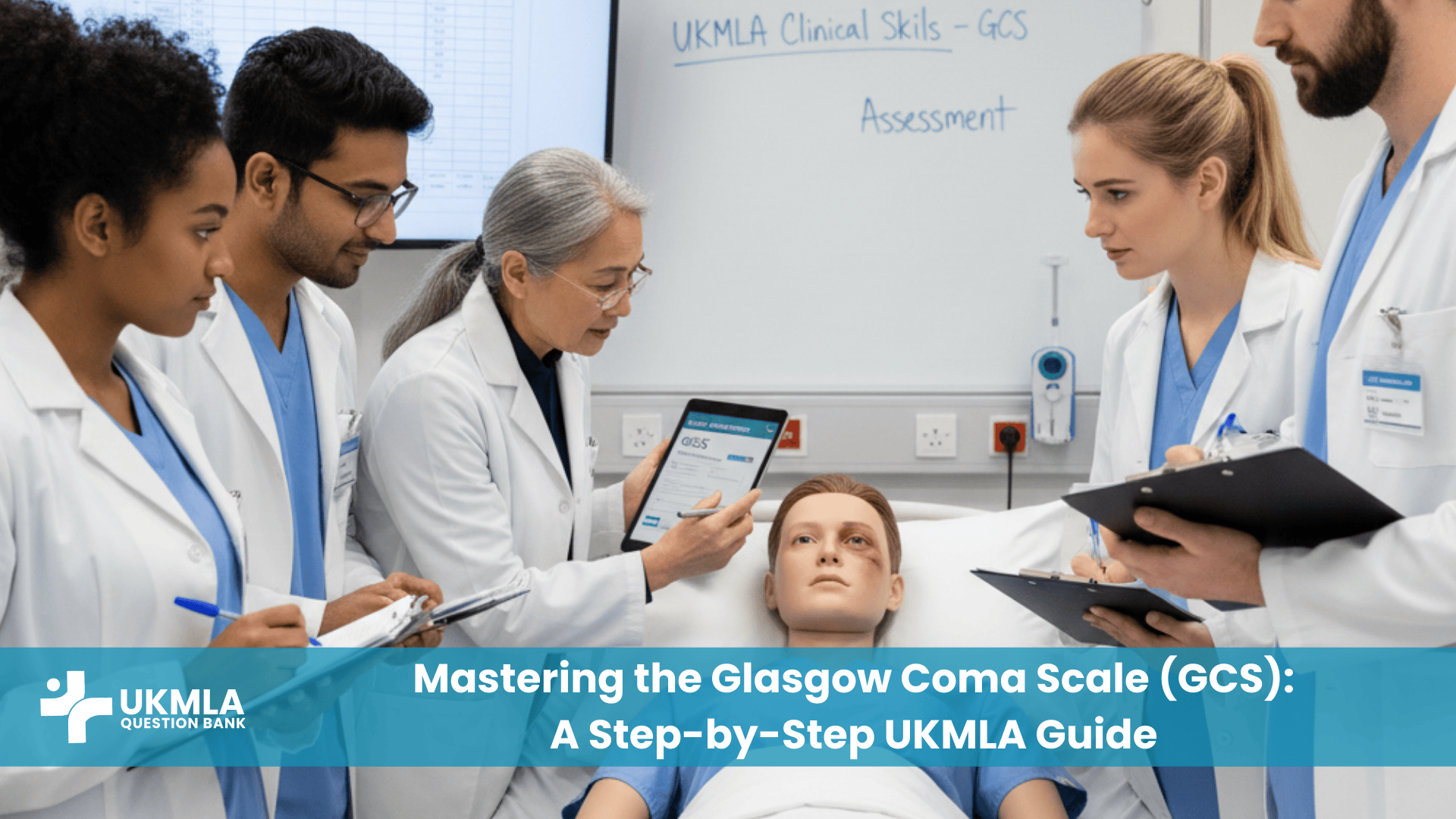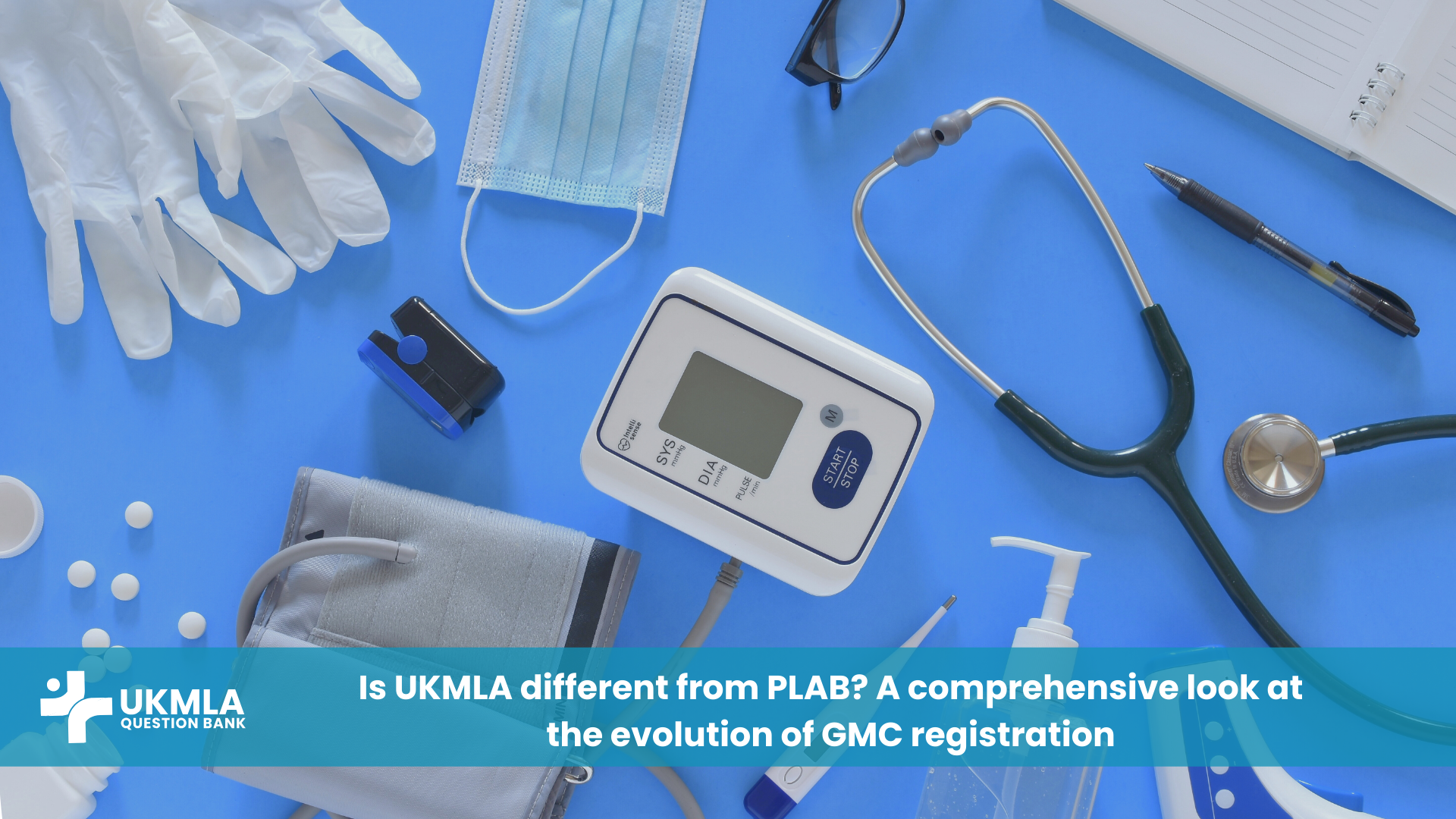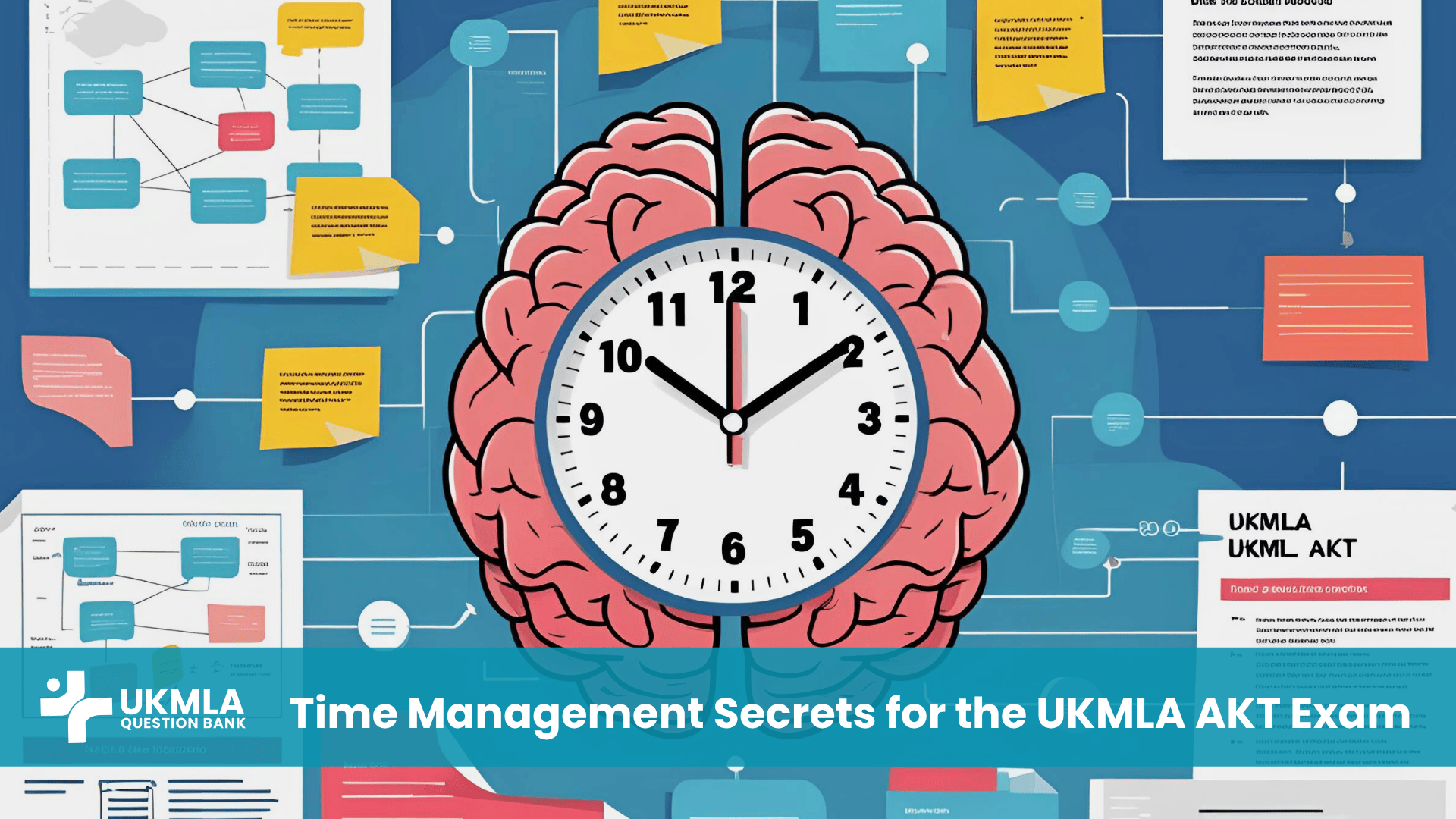Introduction
Learning how to calculate GCS score UKMLA candidates will find is a fundamental skill that bridges the gap between theoretical knowledge and practical, hands-on patient assessment. The Glasgow Coma Scale is the most widely used scoring system for quantifying a patient’s level of consciousness following a brain injury. Its simple, structured approach makes it an invaluable tool in emergency medicine, neurosurgery, and intensive care. For medical students and junior doctors, a fluent understanding of the GCS is not just essential for passing exams—it’s a critical component of safe and effective clinical practice, allowing for clear communication and rapid identification of deteriorating patients.
This guide will demystify the GCS, breaking it down into a clear, memorable, three-step process. We will explore the history and purpose of the scale, detail each of its three components with clinical examples, and explain how to interpret and document your findings. Finally, we will put this knowledge into context with UKMLA-specific scenarios, ensuring you can apply this vital skill with confidence, whether you’re facing a complex AKT question or a high-pressure CPSA station.
Table of Contents
ToggleWhat is the Glasgow Coma Scale?
Before memorising the numbers, it’s important to understand the philosophy behind the GCS. It’s not just a scoring system; it’s a language designed to eliminate ambiguity when describing a patient’s conscious level.
A Brief History and Purpose of the GCS
Developed in 1974 by neurosurgeons Graham Teasdale and Bryan Jennett at the University of Glasgow, the GCS was created to provide a simple yet reliable method for assessing consciousness. Before its invention, terms like “stupor,” “semi-conscious,” or “obtunded” were used, but these descriptions were vague and subjective. The GCS provided a pragmatic solution: a structured assessment of eye, verbal, and motor responses that could be performed consistently by different healthcare professionals. Its primary purpose is to create a shared, objective language for tracking a patient’s neurological status. This is a key piece of knowledge for any student reviewing UKMLA neurology essentials.
Why GCS is More Than Just a Number: Assessing Trends
While the total GCS score is important, its real clinical power lies in monitoring trends over time. A single score is a snapshot; multiple scores create a movie, revealing the trajectory of a patient’s condition. A patient who presents with a GCS of 14 but drops to 12 over the next hour is far more concerning than a patient who presents with a stable GCS of 12. This drop is a red flag that signals potential neurological deterioration, such as an expanding intracranial haematoma, and requires urgent reassessment and intervention.
Blockquote: As its creators intended, the GCS is “an assessment of the depth and duration of impaired consciousness and coma.” Its strength is not in the initial number, but in its ability to be repeated to provide a clear chart of the patient’s progress.
How to Calculate GCS Score UKMLA in 3 Steps
The GCS is composed of three components, each scored independently. The best score for each component is recorded. The core of this process is a structured, 3-step assessment.
Table 1: The Glasgow Coma Scale
| Component | Response | Score |
|---|---|---|
| Eyes (E) | Spontaneously | 4 |
| To Speech | 3 | |
| To Pain | 2 | |
| No Response | 1 | |
| Verbal (V) | Orientated | 5 |
| Confused | 4 | |
| Inappropriate Words | 3 | |
| Incomprehensible Sounds | 2 | |
| No Response | 1 | |
| Motor (M) | Obeys Commands | 6 |
| Localises to Pain | 5 | |
| Withdraws from Pain | 4 | |
| Abnormal Flexion (Decorticate) | 3 | |
| Abnormal Extension (Decerebrate) | 2 | |
| No Response | 1 |
Step 1: Eye Response (E)
This assesses how and why the patient opens their eyes, scored from 4 down to 1.
Spontaneous (4): The patient’s eyes are open before you even speak to them. They are awake and looking around.
To Speech (3): The patient opens their eyes when you speak to them (it doesn’t have to be a loud voice).
To Pain (2): The patient only opens their eyes in response to a painful stimulus, such as a trapezius squeeze or supraorbital pressure.
None (1): The patient does not open their eyes, even with a painful stimulus.
Step 2: Verbal Response (V)
This assesses the quality of the patient’s speech, scored from 5 down to 1.
Orientated (5): The patient can tell you their name, where they are, and the current month/year. They are fully orientated in time, place, and person.
Confused (4): The patient is speaking in full sentences, but the content is disorientated or incorrect. For example, they think it’s 1985 or they are in a different hospital.
Inappropriate Words (3): The patient speaks recognisable words, but they are random, not in sentences, and do not make sense in conversation (e.g., shouting random expletives).
Incomprehensible Sounds (2): The patient is making noises like moaning or groaning but is not forming any recognisable words.
None (1): The patient makes no sound.
Step 3: Motor Response (M)
This assesses the patient’s best motor response, scored from 6 down to 1. This is the most heavily weighted component.
Obeys Commands (6): The patient can follow a simple, two-part command (e.g., “Squeeze my fingers and then let go,” “Stick out your tongue and move it side-to-side”).
Localises to Pain (5): In response to a central painful stimulus (like a trapezius squeeze), the patient purposefully moves their hand above the clavicle to try and remove the source of the pain.
Withdraws from Pain (4): In response to a peripheral painful stimulus (like a nail bed pressure), the patient pulls their limb away from the stimulus. This is a less purposeful movement than localising.
Abnormal Flexion (3): Also known as decorticate posturing. In response to pain, the patient’s arms flex up towards their core, with clenched fists and extended legs.
Abnormal Extension (2): Also known as decerebrate posturing. In response to pain, the patient’s arms extend and internally rotate, with wrists and fingers flexed. This is a more ominous sign than decorticate posturing.
None (1): The patient has no motor response to pain.
Interpreting and Documenting the GCS Score
Once you have the three component scores, you can put it all together. A solid understanding of this is crucial for all emergency medicine scenarios.
The GCS Formula and Correct Documentation
The formula is a simple sum: E + V + M = Total GCS Score. The maximum score is 15, and the minimum is 3. However, simply writing “GCS 10” is poor practice. You must always document the individual components.
Correct format:
GCS 10 (E3 V2 M5) at 15:00Why? A GCS of 10 could be E4 V1 M5 or E2 V4 M4. These represent very different clinical pictures. Documenting the components removes all ambiguity.
Classifying Head Injury Severity
The total GCS score is used to classify the severity of a traumatic brain injury (TBI), as recommended in the official NICE guideline on head injury assessment:
Mild TBI: GCS 13-15
Moderate TBI: GCS 9-12
Severe TBI: GCS 3-8
The Critical Threshold: Why GCS 8 is a Red Flag
You will frequently hear the phrase “GCS less than 8, intubate.” This is a critical clinical heuristic. A GCS of 8 or less indicates a severe impairment of consciousness, and it is strongly associated with the patient’s inability to maintain a patent airway. While not an absolute rule, it serves as a powerful trigger to urgently assess the patient’s airway and breathing and to involve senior help from anaesthetics or intensive care. This is a core principle you might encounter when learning about perioperative and anaesthesia care.
GCS in Practice: UKMLA Scenarios
Let’s apply this knowledge to the exam.
A Worked Example of a UKMLA AKT Question
A 35-year-old man is brought in by ambulance after being found at the bottom of a flight of stairs. When you call his name, he opens his eyes and moans, but says no words. When you perform a trapezius squeeze, he tries to push your hand away. What is his GCS?
GCS 8
GCS 9
GCS 10
GCS 11
GCS 12
Breakdown:
Eyes (E): He opens his eyes to your voice (“call his name”). E = 3.
Verbal (V): He only “moans.” This is an incomprehensible sound. V = 2.
Motor (M): He tries to “push your hand away” from the trapezius squeeze. This is a purposeful movement to remove the pain source. M = 5 (Localises to Pain).
Total: E3 + V2 + M5 = GCS 10. The correct answer is 3. This is how you would apply your knowledge to tackle an AKT SBA question.
Communicating GCS Findings in a CPSA Station
In a CPSA station, you will need to communicate your findings clearly. Imagine handing over a patient to a senior colleague using the SBAR format:
Situation: “This is John Doe, a 40-year-old man who had a fall. His GCS has just dropped.”
Background: “He was GCS 14 on admission half an hour ago, documented as E4 V4 M6.”
Assessment: “On my reassessment just now, his GCS is 11. He is now opening his eyes only to pain, his speech is confused, but he is still obeying commands. That’s E2, V4, M6.”
Recommendation: “I am concerned about a potential intracranial bleed. I think he needs an urgent CT head scan and a neurosurgical review.”
Frequently Asked Questions (FAQ) about Glasgow Coma Scale (GCS)
You document the Verbal score as “1T,” where ‘T’ signifies intubation. The total score is not calculated; you simply report the Eye and Motor scores (e.g., “GCS E2 M4 1T”).
You assess the other eye and document the score with a ‘C’ to denote that the test is not possible on the affected side (e.g., “GCS E3C…”).
The standard GCS is unreliable for young children who haven’t developed full verbal skills. A separate Paediatric Glasgow Coma Scale (pGCS) exists with modified verbal components for pre-verbal children.
Not necessarily. A patient can have a GCS of 15 but still be confused (V4), have focal neurological deficits, or have amnesia. GCS is a measure of conscious level, not a complete neurological exam.
The lowest score is 3 (E1 V1 M1). A score of 0 is not possible. Patients with a GCS of 3 have no eye, verbal, or motor response to stimuli.
Yes, significantly. Intoxication can lower a patient’s GCS. It is crucial to reassess the GCS as the effects of the substances wear off. Never assume a low GCS is solely due to intoxication without ruling out underlying injury.
Localising (M5) is a purposeful, supra-clavicular movement towards a central stimulus (e.g., trapezius squeeze). Withdrawing (M4) is a less specific, reflexive pulling away from a peripheral stimulus (e.g., nail bed pressure).
The use of a sternal rub is now heavily discouraged. It can cause significant bruising and is an unreliable way to test motor response. Peripheral stimuli (nail bed pressure) and central stimuli like the trapezius squeeze or supraorbital notch pressure are preferred.
No. The GCS is a tool for assessing conscious level in living patients. Brainstem death testing is a separate, highly specific clinical protocol performed by senior doctors.
A practiced clinician can perform a reliable GCS assessment in under a minute. It is designed to be a rapid, repeatable, and essential part of patient assessment.
Conclusion
The Glasgow Coma Scale is more than just a set of numbers; it is a fundamental clinical language. By mastering the simple 3-step process of assessing eye, verbal, and motor responses, you equip yourself with a powerful tool for patient care. Understanding how to calculate GCS score UKMLA style means being able to objectively assess a patient, clearly communicate your findings, and recognise neurological deterioration at the earliest possible stage. This skill will serve you not only in your exams but throughout your entire medical career.
As you prepare, practice the scale until it becomes second nature. Use it in clinical simulations, on the wards, and when working through practice questions. A confident and accurate GCS assessment is a hallmark of a competent junior doctor, demonstrating a commitment to patient safety and clear, effective communication. Incorporate this into your UKMLA study plan, and you’ll be well on your way to success.



